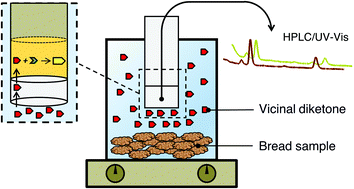Application of gas-diffusion microextraction to solid samples using the chromatographic determination of α-diketones in bread as a case study†
Abstract
Gas-diffusion microextraction (GDME) was applied to the extraction of vicinal diketones in bread samples aimed at the determination of these compounds by high-performance liquid chromatography with ultraviolet detection (HPLC-UV). For the first time, GDME was used for direct chemical determination in solid samples, i.e. avoiding any sample preparation prior to extraction. Different extraction parameters were studied and optimized, namely temperature, time and chemical composition of the acceptor solution where o-phenylenediamine was used as a derivatizing agent, originating quinoxalines that could be determined at 315 nm. GDME demonstrated to be a good tool for the sampling of volatile compounds in solid samples with suitable method features for butane-2,3-dione (diacetyl, DC), pentane-2,3-dione (PN) and hexane-2,3-dione (HX): low LODs (6.0, 8.6 and 12 μg kg−1, for DC, PN and HX respectively) and LOQs (20, 29 and 38 μg kg−1, for DC, PN and HX respectively), r2 above 0.990, and CV around 5%. The developed methodology was applied to the determination of different bread samples and was used to reveal the decrease of α-diketones in bread during the timeframe of a week.


 Please wait while we load your content...
Please wait while we load your content...